Depositional and Paleoenvironmental Controls on Shale Reservoir Heterogeneity in the Wufeng–Longmaxi Formations: A Case Study from the Changning Area, Sichuan Basin, China
Abstract
1. Introduction
2. Geological Setting
3. Samples and Experimental Methods
3.1. Samples
3.2. Whole-Rock Geochemistry
3.3. TOC Analysis
3.4. X-Ray Diffraction
3.5. Argon Ion Polishing Scanning Electron Microscopy and ImageJ Pore Identification
3.6. Proxy Calculations
4. Results
4.1. Mineralogical Composition
4.2. Total Organic Carbon (TOC) Content
4.3. Element Geochemistry
4.3.1. Redox Environment
4.3.2. Terrigenous Detrital Influx Proxies
4.3.3. Degree of Basin Water Retention Proxies
4.3.4. Paleoclimate Proxies
4.3.5. PaleoWater-Depth Proxies
4.3.6. Paleoproductivity Proxies
4.4. Microstructural Characteristics
5. Discussion
5.1. Sedimentary Environmental Controls on Shale Reservoirs
5.1.1. Mineralogical Constraints of Sedimentary Environments
5.1.2. Organic Matter Control by Sedimentary Environment
- i.
- Redox environment
- ii.
- Primary Productivity
- iii.
- Terrigenous detrital influx
5.1.3. Porosity Evolution Under Sedimentary Environment Controls
5.1.4. Sedimentary Environmental Controls on Shale Gas-Bearing Properties
5.2. Sedimentary Evolution Patterns and Reservoir Characteristics
6. Conclusions
Supplementary Materials
Author Contributions
Funding
Data Availability Statement
Acknowledgments
Conflicts of Interest
References
- Zou, C.; Zhu, R.; Chen, Z.; Ogg, J.G.; Wu, S.; Dong, D.; Qiu, Z.; Wang, Y.; Wang, L.; Lin, S.; et al. Organic-matter-rich shales of China. Earth-Sci. Rev. 2019, 189, 51–78. [Google Scholar] [CrossRef]
- Nie, H.; Dang, W.; Zhang, K.; Su, H.; Ding, J.; Li, D.; Liu, X.; Li, P.; Yang, S.; Zhao, J.; et al. Two decades of shale gas research & development in China: Review and prospects. Nat. Gas Ind. 2024, 44, 20–52. [Google Scholar]
- Yong, R.; Yang, H.; Wu, W.; Yang, Y.; Huang, H. Controlling factors and potential of shale gas enrichment and high yield in the Permian Dalong Formation, Sichuan Basin, SW China. Pet. Explor. Dev. 2025, 52, 253–266. [Google Scholar] [CrossRef]
- Wang, T.; Tian, F.; Deng, Z.; Hu, H. Pore structure and fractal characteristics of Wufeng–Longmaxi formation shale in northern Yunnan–Guizhou, China. Front. Earth Sci. 2023, 10, 998958. [Google Scholar] [CrossRef]
- Chen, G.; Dong, D.; Wang, S.; Wang, L. A preliminary study on accumulation mechanism and enrichment pattern of shale gas. Nat. Gas Ind. 2009, 29, 17–21+134–135. [Google Scholar]
- Selley, R.C. Ancient Sedimentary Environments; Chapman and Hall, Ltd.: London, UK, 1970. [Google Scholar]
- Kennedy, M.; Droser, M.; Mayer, L.M.; Pevear, D.; Mrofka, D. Late Precambrian Oxygenation; Inception of the Clay Mineral Factory. Science 2006, 311, 1446–1449. [Google Scholar] [CrossRef] [PubMed]
- Pichevin, L.; Bertrand, P.; Boussafir, M.; Disnar, J. Organic matter accumulation and preservation controls in a deep sea modern environment: An example from Namibian slope sediments. Org. Geochem. 2004, 35, 543–559. [Google Scholar] [CrossRef]
- Tang, L.; Song, Y.; Jiang, S.; Jiang, Z.; Li, Z.; Yang, Y.; Li, X.; Xiao, L. Organic matter accumulation of the Wufeng-Longmaxi shales in southern Sichuan Basin: Evidence and insight from volcanism. Mar. Pet. Geol. 2020, 120, 104564. [Google Scholar] [CrossRef]
- Cichon-Pupienis, A.; Littke, R.; Lazauskiene, J.; Baniasad, A.; Pupienis, D.; Radzevicius, S.; Siliauskas, L. Geochemical and sedimentary facies study—Implication for driving mechanisms of organic matter enrichment in the lower Silurian fine-grained mudstones in the Baltic Basin (W Lithuania). Int. J. Coal. Geol. 2021, 244, 103815. [Google Scholar] [CrossRef]
- Peng, Y.; Guo, S. Lithofacies analysis and paleosedimentary evolution of Taiyuan Formation in Southern North China Basin. Geoenergy Sci. Eng. 2023, 220, 111127. [Google Scholar] [CrossRef]
- Arthur, M.A.; Dean, W.E.; Laarkamp, K. Organic carbon accumulation and preservation in surface sediments on the Peru margin. Chem. Geol. 1998, 152, 273–286. [Google Scholar] [CrossRef]
- Basilone, L.; Perri, F.; Sulli, A.; Critelli, S. Paleoclimate and extensional tectonics of short-lived lacustrine environments. Lower Cretaceous of the Panormide Southern Tethyan carbonate platform (NW Sicily). Mar. Pet. Geol. 2017, 88, 428–439. [Google Scholar] [CrossRef]
- Mort, H.; Jacquat, O.; Adatte, T.; Steinmann, P.; Föllmi, K.; Matera, V.; Berner, Z.; Stüben, D. The Cenomanian/Turonian anoxic event at the Bonarelli Level in Italy and Spain: Enhanced productivity and/or better preservation? Cretac. Res. 2007, 28, 597–612. [Google Scholar] [CrossRef]
- Wei, H.; Chen, D.; Wang, J.; Yu, H.; Tucker, M.E. Organic accumulation in the lower Chihsia Formation (Middle Permian) of South China: Constraints from pyrite morphology and multiple geochemical proxies. Palaeogeogr. Palaeoclimatol. Palaeoecol. 2012, 353–355, 73–86. [Google Scholar] [CrossRef]
- Demaison, G.J.; Moore, G.T. Anoxic environments and oil source bed genesis. Org. Geochem. 1980, 2, 9–31. [Google Scholar] [CrossRef]
- Fang, X.; Zhang, Q.; Wu, L.; Geng, A.; Liu, S.; Wang, P.; Liang, X. Origin and preservation mechanisms of organic matter in carbonate concretions from Lower Cambrian black shales in South China. Org. Geochem. 2024, 197, 104876. [Google Scholar] [CrossRef]
- Hatch, J.R.; Jacobson, S.R.; Witzke, B.J.; Risatti, J.B.; Anders, D.E.; Watney, W.L.; Newell, K.D.; Vuletich, A.K. Possible Late Middle Ordovician Organic Carbon Isotope Excursion: Evidence from Ordovician Oils and Hydrocarbon Source Rocks, Mid-Continent and East-Central United States1. AAPG Bull. 1987, 71, 1342–1354. [Google Scholar]
- Sequero, C.; Aurell, M.; Bádenas, B. Sedimentary evolution of a shallow carbonate ramp (Kimmeridgian, NE Spain): Unravelling controlling factors for facies heterogeneities at reservoir scale. Mar. Pet. Geol. 2019, 109, 145–174. [Google Scholar] [CrossRef]
- Hussain, A.; Haughton, P.D.W.; Shannon, P.M.; Morris, E.A.; Pierce, C.S.; Omma, J.E. Mud-forced turbulence dampening facilitates rapid burial and enhanced preservation of terrestrial organic matter in deep-sea environments. Mar. Pet. Geol. 2021, 130, 105101. [Google Scholar] [CrossRef]
- Song, Y.; Li, S.; Hu, S. Warm-humid paleoclimate control of salinized lacustrine organic-rich shale deposition in the Oligocene Hetaoyuan Formation of the Biyang Depression, East China. Int. J. Coal Geol. 2019, 202, 69–84. [Google Scholar] [CrossRef]
- Basilone, L.; Bernardini, S.; Grassa, F.; Sulli, A.; Nieto, L.M.; Abbassi, A.; Jovane, L. Paleo-redox conditions during the demise of a carbonate platform in the Tethyan ocean: Evidence from phosphatized and metals (Mn and Fe) rich hardgrounds. Mar. Pet. Geol. 2024, 170, 107121. [Google Scholar] [CrossRef]
- Zhang, X.; He, J.; Ren, Z.; Zhou, T.; Shi, S.; Zhao, Y. Paleo-lake Water Stratification in the Chang 7 Age of the Triassic and its Significance for Shale Gas Accumulation in the Ordos Basin. J. Coast. Res. 2019, 93, 170. [Google Scholar] [CrossRef]
- Mao, X.; Chen, X.; Li, Z.; Li, S.; Li, S.; Zhu, Q. Shale Sedimentary Patterns and Organic Matter Enrichment Patterns of the Wufeng-Longmaxi Formation in the Sichuan Basin. Acta Sedimentol. Sin. 2025, 43, 701. [Google Scholar]
- Bohacs, K.M., Jr.; Grabowski, G.J.; Carroll, A.R.; Mankiewicz, P.J.; Miskell-Gerhardt, K.J.; Schwalbach, J.R.; Wegner, M.B.; Simo, J.A.T. Production, Destruction, and Dilution—The Many Paths to Source-Rock Development. In The Deposition of Organic-Carbon-Rich Sediments: Models, Mechanisms, and Consequences; Harris, N.B., Ed.; SEPM Society for Sedimentary Geology: Tulsa, OK, USA, 2005. [Google Scholar]
- Chen, L.; Chen, X.; Tan, X.; Zheng, J.; Yang, Y.; Jing, C.; Zhou, H.; Wang, G. Factors controlling organic matter accumulation in the Longmaxi Formation shale, Changning area, South Sichuan Basin. Geomech. Geophys. Geo-Energy Geo-Resour. 2023, 9, 89. [Google Scholar] [CrossRef]
- Lu, R.; He, D.; Liu, J.Z.; Tao, W.; Huang, H.; Xu, F.; Liu, G. Seismogenic Faults of the Changning Earthquake Sequence Constrained by High-Resolution Seismic Profiles in the Southwestern Sichuan Basin, China. Seismol. Res. Lett. 2021, 92, 3757–3766. [Google Scholar] [CrossRef]
- Wang, Y.; Xu, S.; Hao, F.; Lu, Y.; Shu, Z.; Yan, D.; Lu, Y. Geochemical and petrographic characteristics of Wufeng-Longmaxi shales, Jiaoshiba area, southwest China: Implications for organic matter differential accumulation. Mar. Pet. Geol. 2019, 102, 138–154. [Google Scholar] [CrossRef]
- Chen, X.; Rong, J.; Fan, J.; Zhan, R.; Mitchell, C.; Harper, D.; Melchin, M.; Ping’An, P.; Finney, S.; Wang, X. The Global Boundary Stratotype Section and Point (GSSP) for the base of the Hirnantian Stage (the uppermost of the Ordovician System). Episodes 2006, 29, 183–195. [Google Scholar] [CrossRef]
- Chen, X.; Fan, J.; Zhang, Y.; Wang, H.; Chen, Q.; Wang, W.; Liang, F.; Guo, W.; Zhao, Q.; Nie, H.; et al. Subdivision and Delineation of the Wufeng and Lungmachi Black Shales In The Subsurface Areas of The Yangtze Platform. J. Stratigr. 2015, 39, 351–358. [Google Scholar]
- Tribovillard, N.; Algeo, T.J.; Lyons, T.; Riboulleau, A. Trace metals as paleoredox and paleoproductivity proxies: An update. Chem. Geol. 2006, 232, 12–32. [Google Scholar] [CrossRef]
- Tribovillard, N.; Riboulleau, A.; Lyons, T.; Baudin, F. Enhanced trapping of molybdenum by sulfurized marine organic matter of marine origin in Mesozoic limestones and shales. Chem. Geol. 2004, 213, 385–401. [Google Scholar] [CrossRef]
- Van der Weijden, C.H. Pitfalls of normalization of marine geochemical data using a common divisor. Mar. Geol. 2002, 184, 167–187. [Google Scholar] [CrossRef]
- Calvert, S.E.; Pedersen, T.F. Geochemistry of Recent oxic and anoxic marine sediments: Implications for the geological record. Mar. Geol. 1993, 113, 67–88. [Google Scholar] [CrossRef]
- Taylor, S.R.; McLennan, S.M. The Continental Crust: Its Composition and Evolution; Blackwell Scientific Pub.: Palo Alto, CA, USA, 1985. [Google Scholar]
- Algeo, T.J.; Lyons, T.W. Mo-total organic carbon covariation in modern anoxic marine environments; implications for analysis of paleoredox and paleohydrographic conditions. Paleoceanography 2006, 21. [Google Scholar] [CrossRef]
- Fedo, C.M.; Young, G.M.; Nesbitt, H.W.; Hanchar, J.M. Potassic and sodic metasomatism in the Southern Province of the Canadian Shield: Evidence from the Paleoproterozoic Serpent Formation, Huronian Supergroup, Canada. Precambrian Res. 1997, 84, 17–36. [Google Scholar] [CrossRef]
- Fedo, C.M.; Wayne Nesbitt, H.; Young, G.M. Unraveling the effects of potassium metasomatism in sedimentary rocks and paleosols, with implications for paleoweathering conditions and provenance. Geology 1995, 23, 921–924. [Google Scholar] [CrossRef]
- Murray, R.W.; Leinen, M. Scavenged excess aluminum and its relationship to bulk titanium in biogenic sediment from the central equatorial Pacific Ocean. Geochim. Cosmochim. Acta 1996, 60, 3869–3878. [Google Scholar] [CrossRef]
- Pi, D.; Liu, C.; Shields-Zhou, G.A.; Jiang, S. Trace and rare earth element geochemistry of black shale and kerogen in the early Cambrian Niutitang Formation in Guizhou province, South China: Constraints for redox environments and origin of metal enrichments. Precambrian Res. 2013, 225, 218–229. [Google Scholar] [CrossRef]
- Hatch, J.R.; Leventhal, J.S. Relationship between inferred redox potential of the depositional environment and geochemistry of the Upper Pennsylvanian (Missourian) Stark Shale Member of the Dennis Limestone, Wabaunsee County, Kansas, U.S.A. Chem. Geol. 1992, 99, 65–82. [Google Scholar] [CrossRef]
- Jones, B.; Manning, D.A.C. Comparison of geochemical indices used for the interpretation of palaeoredox conditions in ancient mudstones. Chem. Geol. 1994, 111, 111–129. [Google Scholar] [CrossRef]
- Wignall, P.B.; Twitchett, R.J. Oceanic Anoxia and the End Permian Mass Extinction. Science 1996, 272, 1155–1158. [Google Scholar] [CrossRef]
- Lewan, M.D.; Maynard, J.B. Factors controlling enrichment of vanadium and nickel in the bitumen of organic sedimentary rocks. Geochim. Cosmochim. Acta 1982, 46, 2547–2560. [Google Scholar] [CrossRef]
- Liao, C.; Chen, L.; Gu, Z.; Liu, B.; Yang, L.; Tan, X.; Xiong, M.; Cao, J. Characteristics, genetic types and mechanisms of marine organic-rich shale reservoirs: A case study of the Wufeng-Longmaxi Formations in Changning area, southern Sichuan Basin. J. Palaeogeogr. (Chin. Ed.) 2025, 27, 714–730. [Google Scholar]
- Peng, L.; Liu, X.P.; Lin, C.; Liu, J.Y.; Yang, X.F.; Wang, H.; Li, H.P. Late Ordovician palaeogeomorphology and its sedimentary facies characteristics in central Tarim uplift. Oil Geophys. Prospect. 2009, 44, 767–772. [Google Scholar]
- Algeo, T.J.; Tribovillard, N. Environmental analysis of paleoceanographic systems based on molybdenum–uranium covariation. Chem. Geol. 2009, 268, 211–225. [Google Scholar] [CrossRef]
- Tribovillard, N.; Algeo, T.J.; Baudin, F.; Riboulleau, A. Analysis of marine environmental conditions based onmolybdenum–uranium covariation—Applications to Mesozoic paleoceanography. Chem. Geol. 2012, 324–325, 46–58. [Google Scholar] [CrossRef]
- Wang, H.; Shi, Z.; Sun, S.; Zhao, Q.; Zhou, T.; Cheng, F.; Bai, W. Microfacies types and distribution of epicontinental shale: A case study of the Wufeng-Longmaxi shale in southern Sichuan Basin, China. Pet. Explor. Dev. 2023, 50, 57–71. [Google Scholar] [CrossRef]
- Cai, Q.; Hu, M.; Kane, O.; Li, M.; Zhang, B.; Hu, Z.; Deng, Q.; Xing, N. Cyclic variations in paleoenvironment and organic matter accumulation of the Upper Ordovician-Lower Silurian black shale in the Middle Yangtze Region, South China: Implications for tectonic setting, paleoclimate, and sea-level change. Mar. Pet. Geol. 2022, 136, 105477. [Google Scholar] [CrossRef]
- Nesbitt, H.W.; Young, G.M. Early Proterozoic climates and plate motions inferred from major element chemistry of lutites. Nature 1982, 299, 715–717. [Google Scholar] [CrossRef]
- Guan, Q.Z.; Dong, D.Z.; Zhang, H.L.; Sun, S.S.; Zhang, S.R.; Guo, W. Types of biogenic quartz and its coupling storage mechanism in organic-rich shales: A case study of the Upper Ordovician Wufeng Formation to Lower Silurian Longmaxi Formation in the Sichuan Basin, SW China. Pet. Explor. Dev. 2021, 48, 813–823. [Google Scholar] [CrossRef]
- Lu, L.; Qin, J.; Shen, B.; Tenger; Liu, W.; Zhang, Q. The origin of biogenic silica in siliceous shale from Wufeng-Longmaxi Formation in the Middle and Upper Yangtze region and its relationship with shale gas enrichment. Earth Sci. Front. 2018, 25, 226–236. [Google Scholar]
- Lein, A.Y.; Kravchishina, M.D. Barium Geochemical Cycle in the Ocean. Lithol. Miner. Resour. 2021, 56, 293–308. [Google Scholar] [CrossRef]
- Zhao, M.; Mills, B.J.W.; Poulton, S.W.; Wan, B.; Xiao, K.; Guo, L.; Guo, Z. Drivers of the global phosphorus cycle over geological time. Nat. Rev. Earth Environ. 2024, 5, 873–889. [Google Scholar] [CrossRef]
- Pszonka, J.; Žecová, K.; Wendorff, M. Oligocene turbidite fans of the Dukla Basin: New age data from the calcareous nannofossils and paleoenvironmental conditions (Cergowa beds, Polish-Slovakian borderland). Geol. Carpath. 2019, 70, 311–324. [Google Scholar] [CrossRef]
- Ding, X.; He, W.; Liu, H.; Guo, X.; Zha, M.; Jiang, Z. Organic matter accumulation in lacustrine shale of the Permian Jimsar Sag, Junggar Basin, NW China. Pet. Sci. 2023, 20, 1327–1346. [Google Scholar] [CrossRef]
- Hirajima, T.; Aiba, Y.; Farahat, M.; Okibe, N.; Sasaki, K.; Tsuruta, T.; Doi, K. Effect of microorganisms on flocculation of quartz. Int. J. Miner. Process. 2012, 102–103, 107–111. [Google Scholar] [CrossRef]
- Warren, J. Dolomite: Occurrence, evolution and economically important associations. Earth-Sci. Rev. 2000, 52, 1–81. [Google Scholar] [CrossRef]
- Bau, S.; Witschger, O.; Gensdarmes, F.; Thomas, D. Determining the count median diameter of nanoaerosols by simultaneously measuring their number and lung-deposited surface area concentrations. J. Nanoparticle Res. 2013, 15, 2104. [Google Scholar] [CrossRef]
- Shen, J.; Algeo, T.J.; Zhou, L.; Feng, Q.; Yu, J.; Ellwood, B. Volcanic perturbations of the marine environment in South China preceding the latest Permian mass extinction and their biotic effects. Geobiology 2012, 10, 82–103. [Google Scholar] [CrossRef]
- Shen, J.; Algeo, T.J.; Hu, Q.; Xu, G.; Zhou, L.; Feng, Q. Volcanism in South China during the Late Permian and its relationship to marine ecosystem and environmental changes. Glob. Planet Change 2013, 105, 121–134. [Google Scholar] [CrossRef]
- Liang, C.; Ji, S.; Cao, Y.; Liu, K.; Wu, J.; Hao, F. Characteristics, origins, and significance of pyrites in deep-water shales. Sci. China Earth Sci. 2024, 67, 313–342. [Google Scholar] [CrossRef]
- Sageman, B.B.; Murphy, A.E.; Werne, J.P.; Ver Straeten, C.A.; Hollander, D.J.; Lyons, T.W. A tale of shales: The relative roles of production, decomposition, and dilution in the accumulation of organic-rich strata, Middle–Upper Devonian, Appalachian basin. Chem. Geol. 2003, 195, 229–273. [Google Scholar] [CrossRef]
- Tyson, R.V. The “Productivity Versus Preservation” Controversy: Cause, Flaws, and Resolution. In The Deposition of Organic-Carbon-Rich Sediments: Models, Mechanisms, and Consequences; Harris, N.B., Ed.; SEPM Society for Sedimentary Geology: Tulsa, OK, USA, 2005; Volume 82. [Google Scholar]
- Curtis, M.E.; Cardott, B.J.; Sondergeld, C.H.; Rai, C.S. Development of organic porosity in the Woodford Shale with increasing thermal maturity. Int. J. Coal Geol. 2012, 103, 26–31. [Google Scholar] [CrossRef]
- Loucks, R.G.; Reed, R.M.; Ruppel, S.C.; Jarvie, D.M. Morphology, Genesis, and Distribution of Nanometer-Scale Pores in Siliceous Mudstones of the Mississippian Barnett Shale. J. Sediment. Res. 2009, 79, 848–861. [Google Scholar] [CrossRef]
- Li, Y.; Liu, H.; Zhang, L.; Lv, Z.; Li, Q.; Huang, Y. Lower limits of evaluation parameters for the lower Paleozoic Longmaxi shale gas in southern Sichuan Province. Sci. China Earth Sci. 2013, 43, 1088–1095. [Google Scholar] [CrossRef]
- Boyer, C.; Kieschnick, J.; Suarez-Rivera, R.; Lewis, R.E.; Waters, G. Producing gas from its source. Oilfield Rev. 2006, 18, 36–49. [Google Scholar]
- Zou, C.; Dong, D.; Yang, Y.; Wang, Y.; Huang, J.; Wang, S.; Fu, C. Conditions of shale gas accumulation and exploration practices in China. Nat. Gas Ind. 2011, 31, 26–39+125. [Google Scholar]
- Ross, D.J.K.; Marc Bustin, R. The importance of shale composition and pore structure upon gas storage potential of shale gas reservoirs. Mar. Pet. Geol. 2009, 26, 916–927. [Google Scholar] [CrossRef]
- Zhang, Q.; Liu, H.; Bai, W.; Lin, W. Shale gas content and its main controlling factors in Longmaxi shales in southeastern Chongqing. Nat. Gas Ind. 2013, 33, 35–39. [Google Scholar]
- Wang, Y.; Zhang, H.; Zhu, Y.; Chen, S.; Cao, Q.; Huang, M.; Yang, J.; Zhang, Y. Sedimentary environment and major controlling factors of organic matter-rich shale from the Wufeng-Longmaxi formation in eastern Sichuan Basin, China. Front. Earth Sci. 2024, 18, 649–670. [Google Scholar] [CrossRef]
- Chen, L.; Wang, G.; Yang, Y.; Jing, C.; Chen, M.; Tan, X. Geochemical Characteristics of Bentonite and Its Influence on Shale Reservoir Quality in Wufeng–Longmaxi Formation, South Sichuan Basin, China. Energy Fuel 2019, 33, 12366–12373. [Google Scholar] [CrossRef]
- Wu, L.; Lu, Y.; Jiang, S.; Liu, X.; He, G. Effects of volcanic activities in Ordovician Wufeng–Silurian Longmaxi period on organic-rich shale in the Upper Yangtze area, South China. Pet. Explor. Dev. 2018, 45, 862–872. [Google Scholar] [CrossRef]
- Liu, Y.; Wu, B.; Gong, Q.; Cao, H. Geochemical characteristics of the lower Silurian Longmaxi Formation on the Yangtze Platform, South China: Implications for depositional environment and accumulation of organic matters. J. Asian Earth Sci. 2019, 184, 104003. [Google Scholar] [CrossRef]
- Hu, R.; Tan, J.; Dick, J.; Wang, Y.; Li, G.; Liu, C. Depositional conditions of siliceous microfossil-rich shale during the Ordovician–Silurian transition of south China: Implication for organic matter enrichment. Mar. Pet. Geol. 2023, 154, 106307. [Google Scholar] [CrossRef]
- Wang, Y.; Li, X.; Dong, D.; Zhang, C.; Wang, S. Main factors controlling the sedimentation of high-quality shale in Wufeng-Longmaxi Fm, Upper Yangtze region. Nat. Gas Ind. 2017, 37, 9–20. [Google Scholar] [CrossRef]
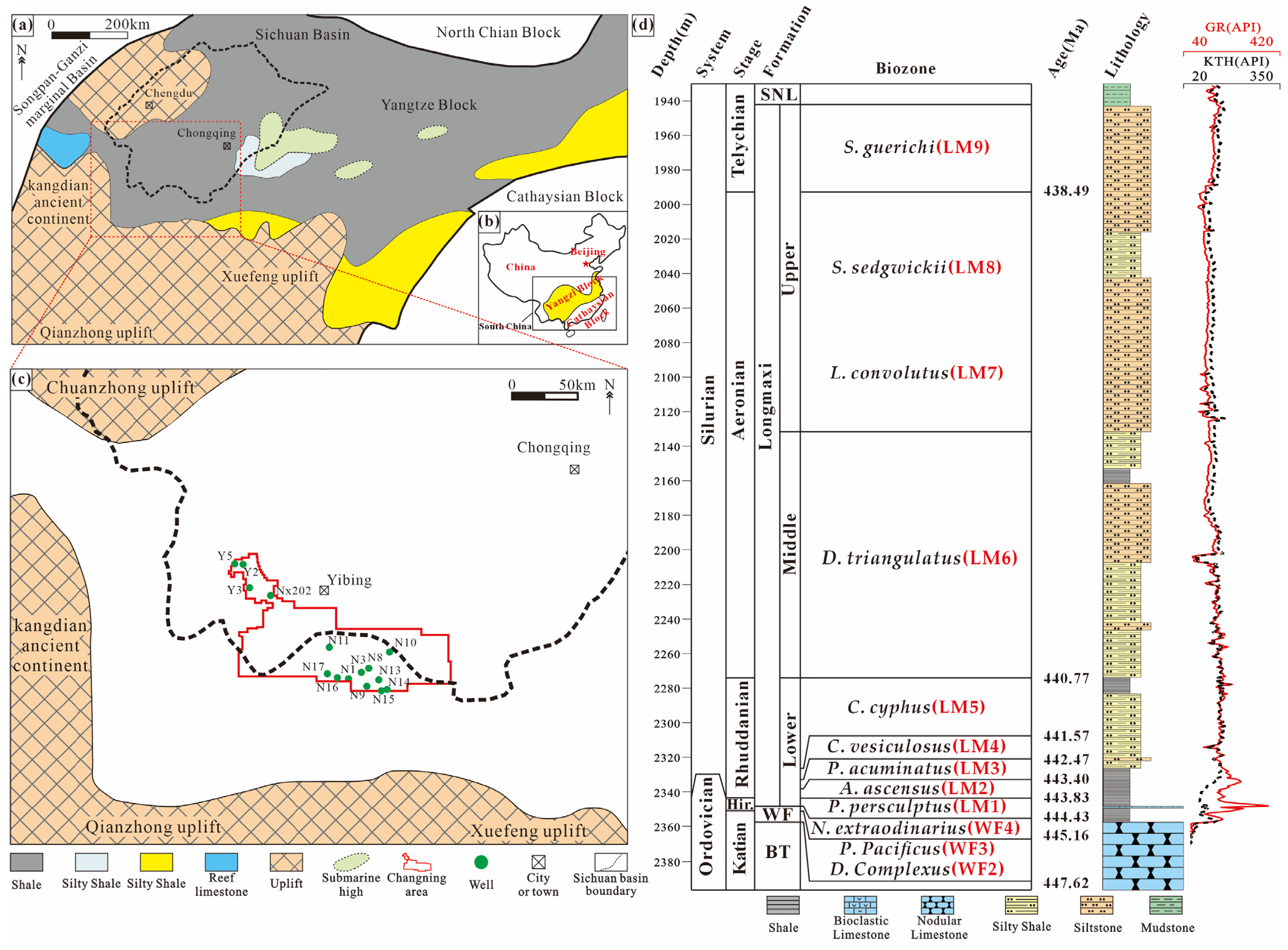
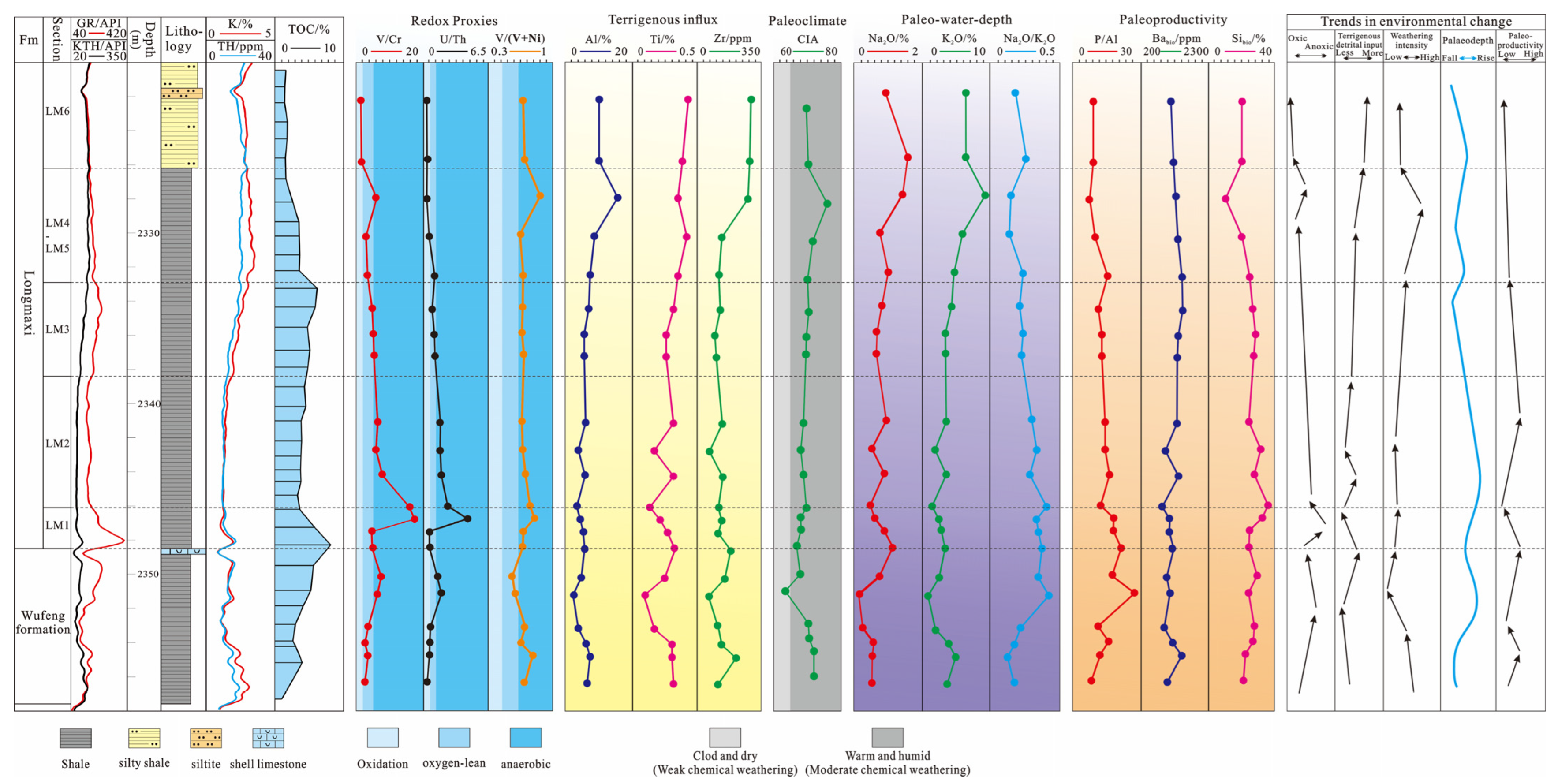

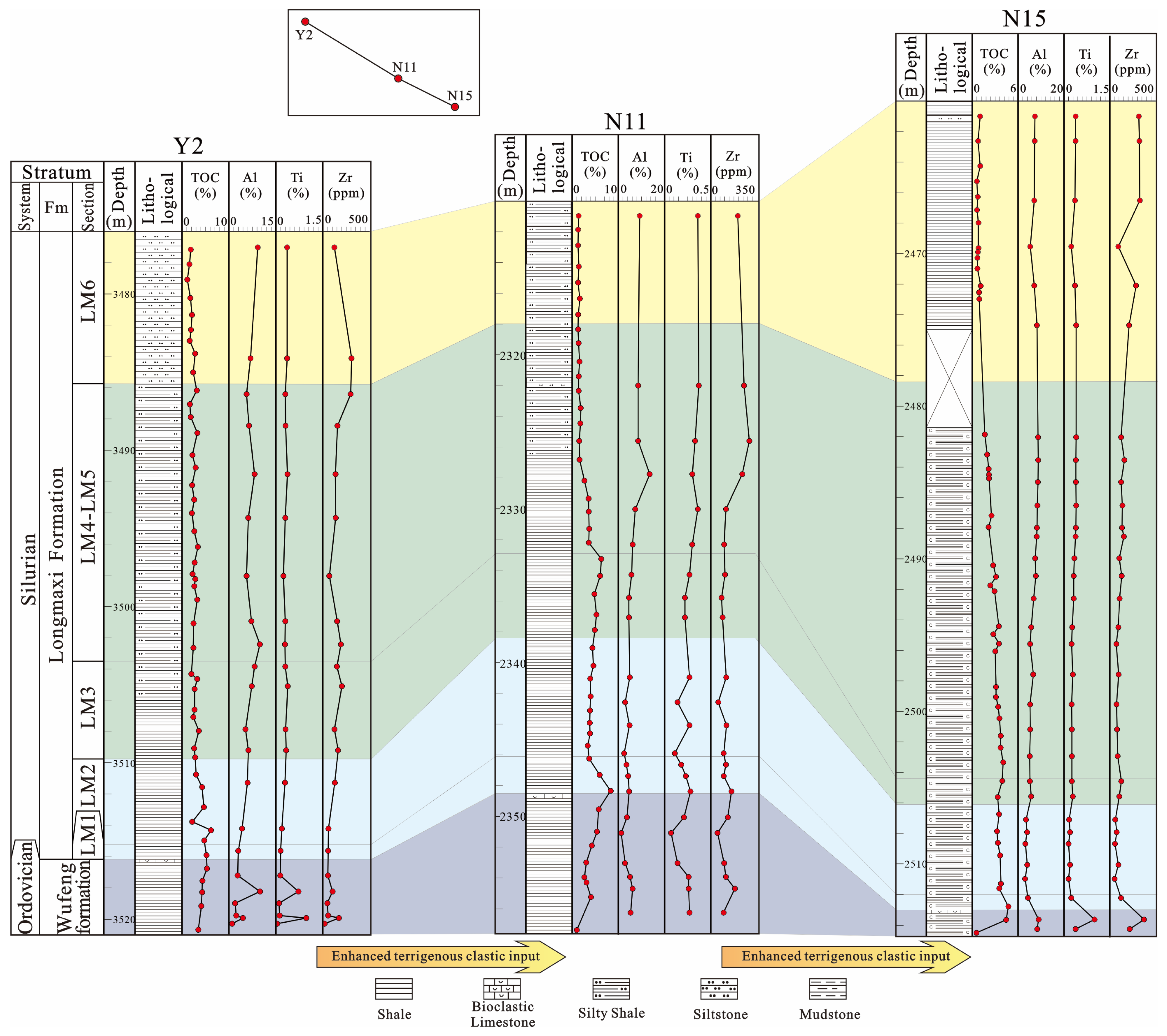
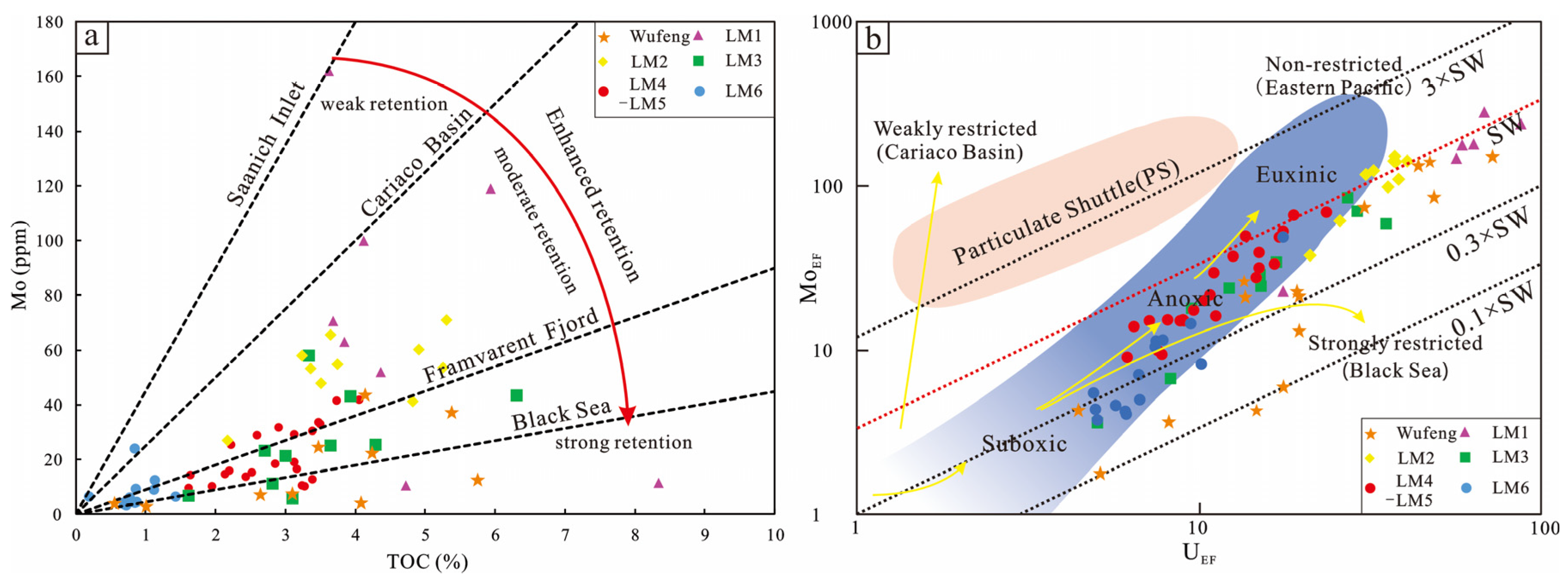
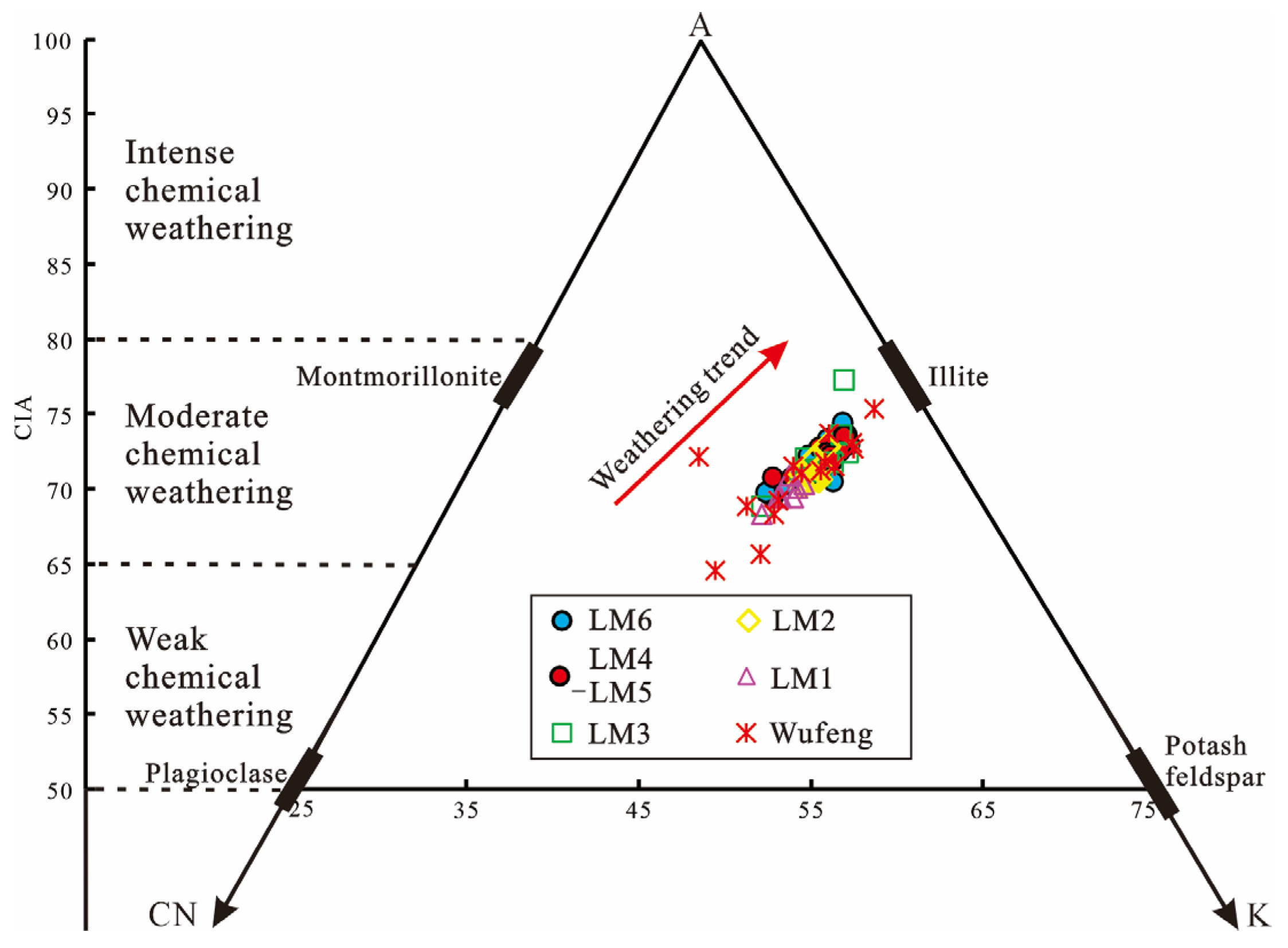
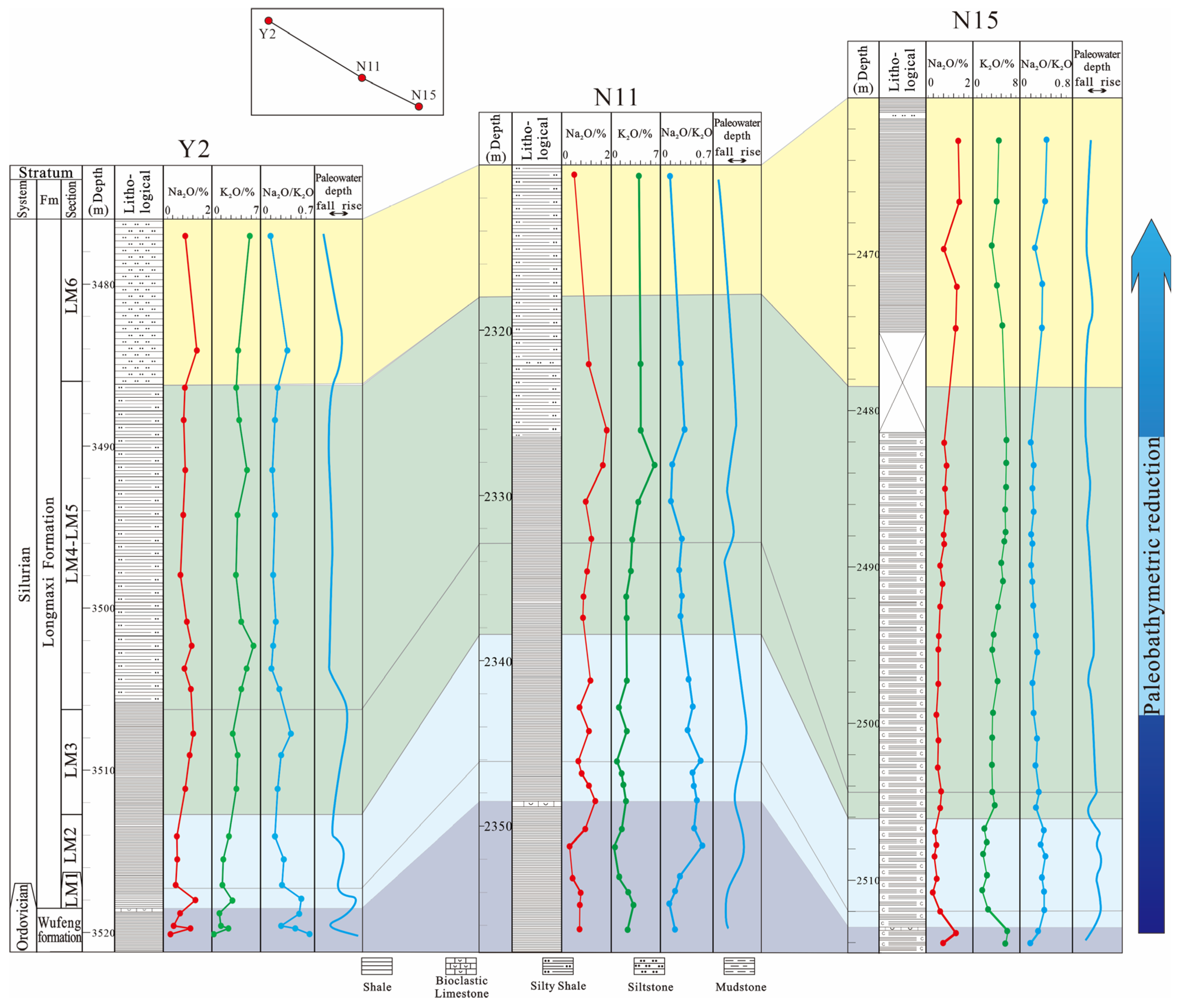
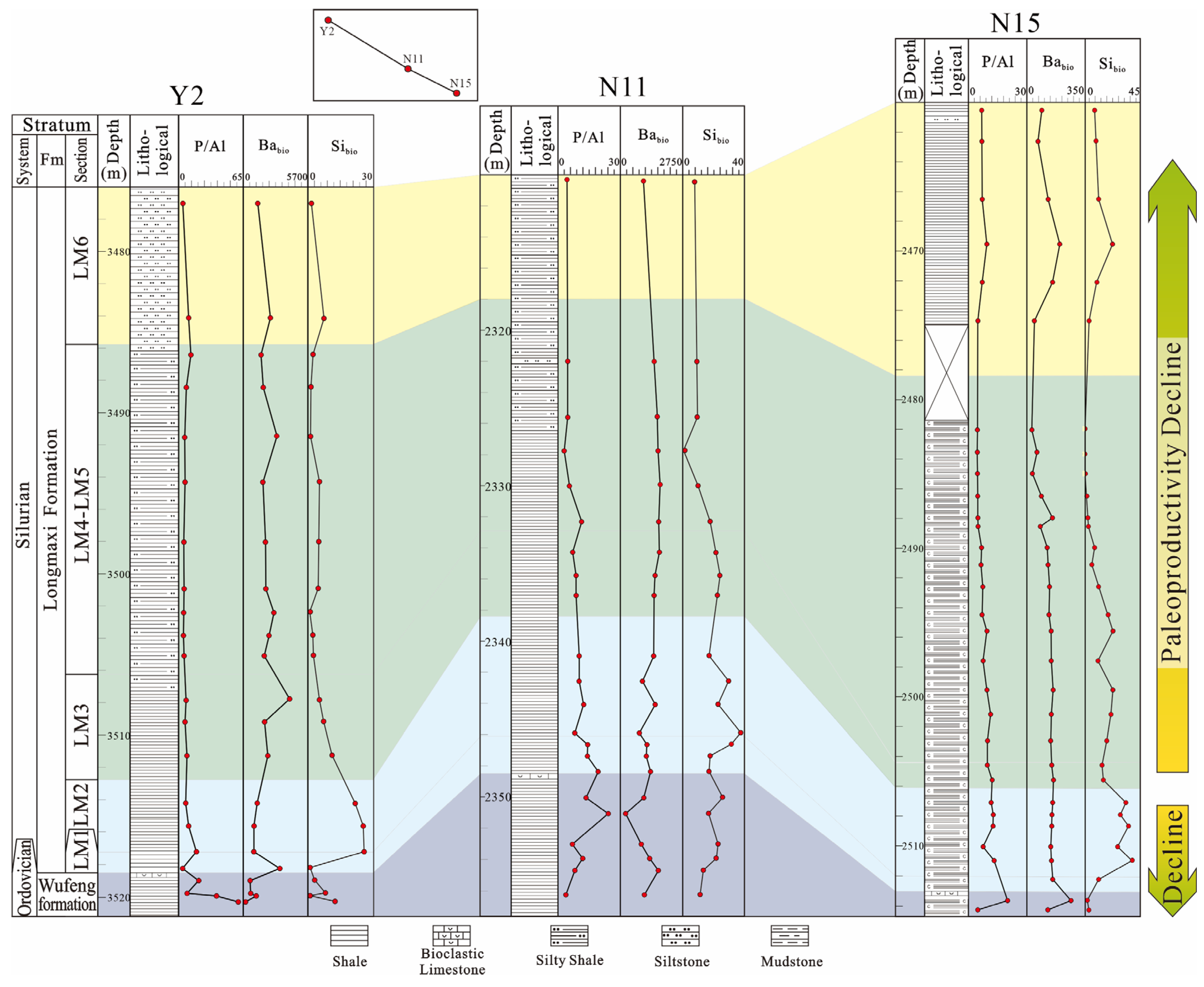
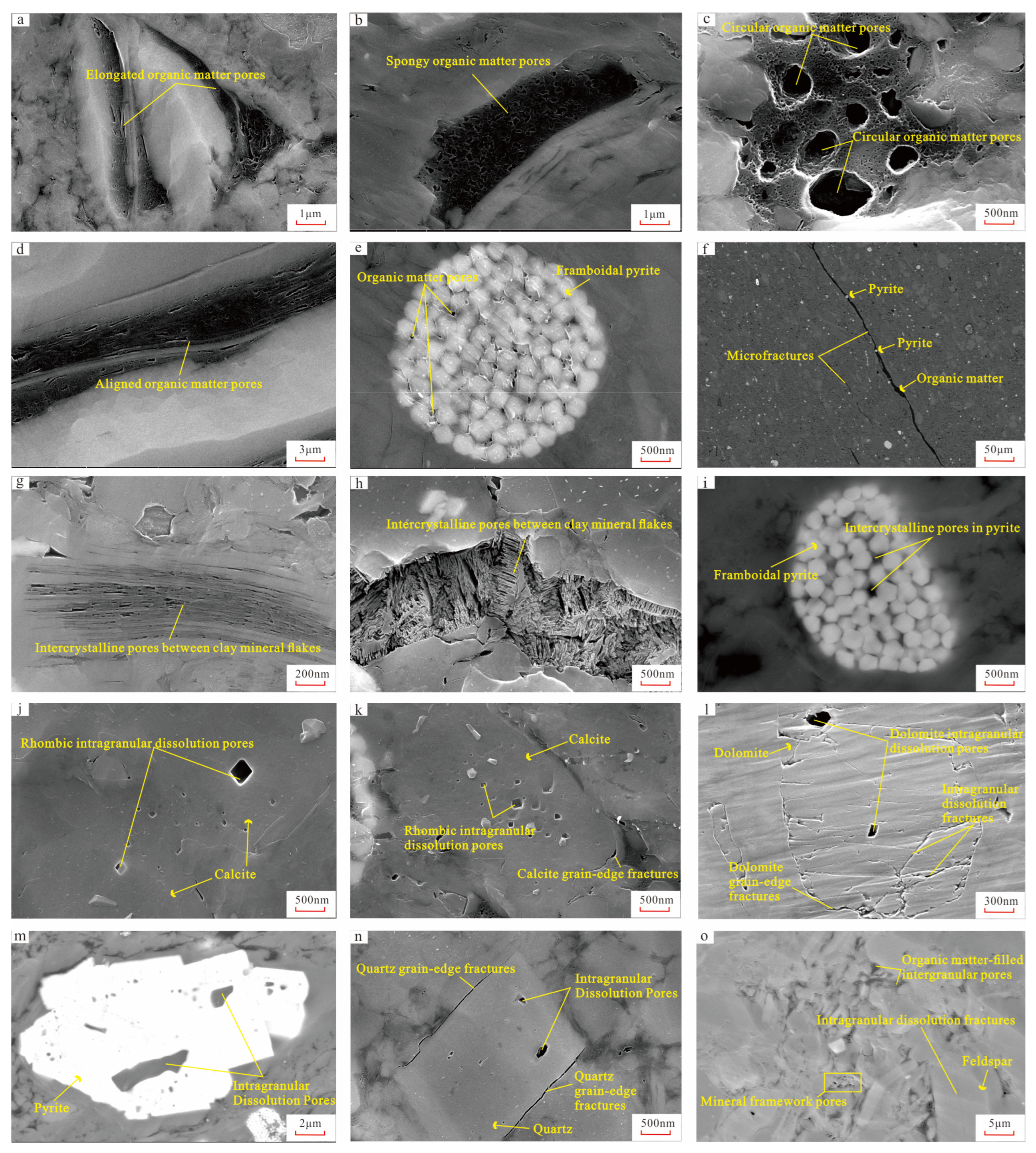
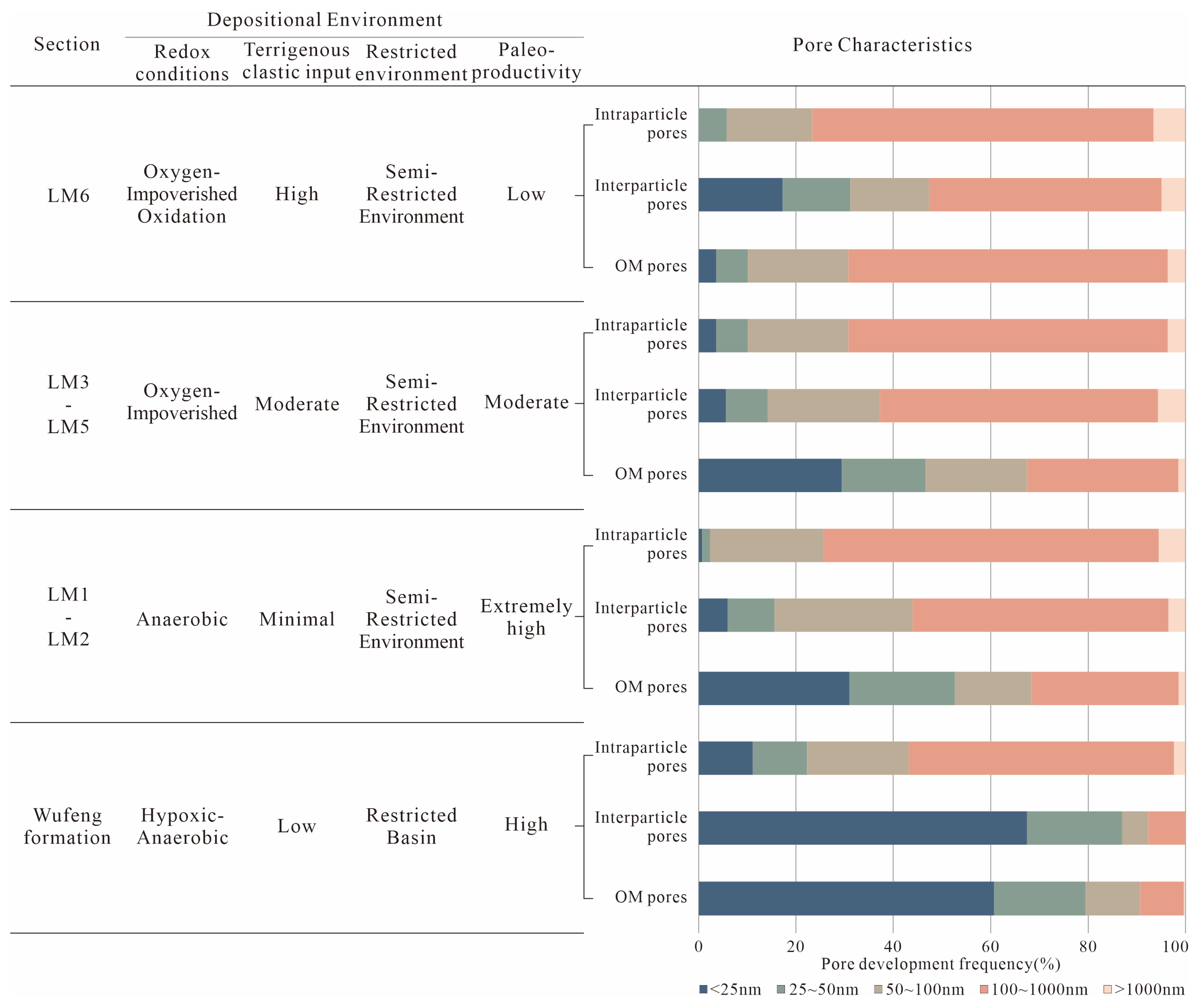
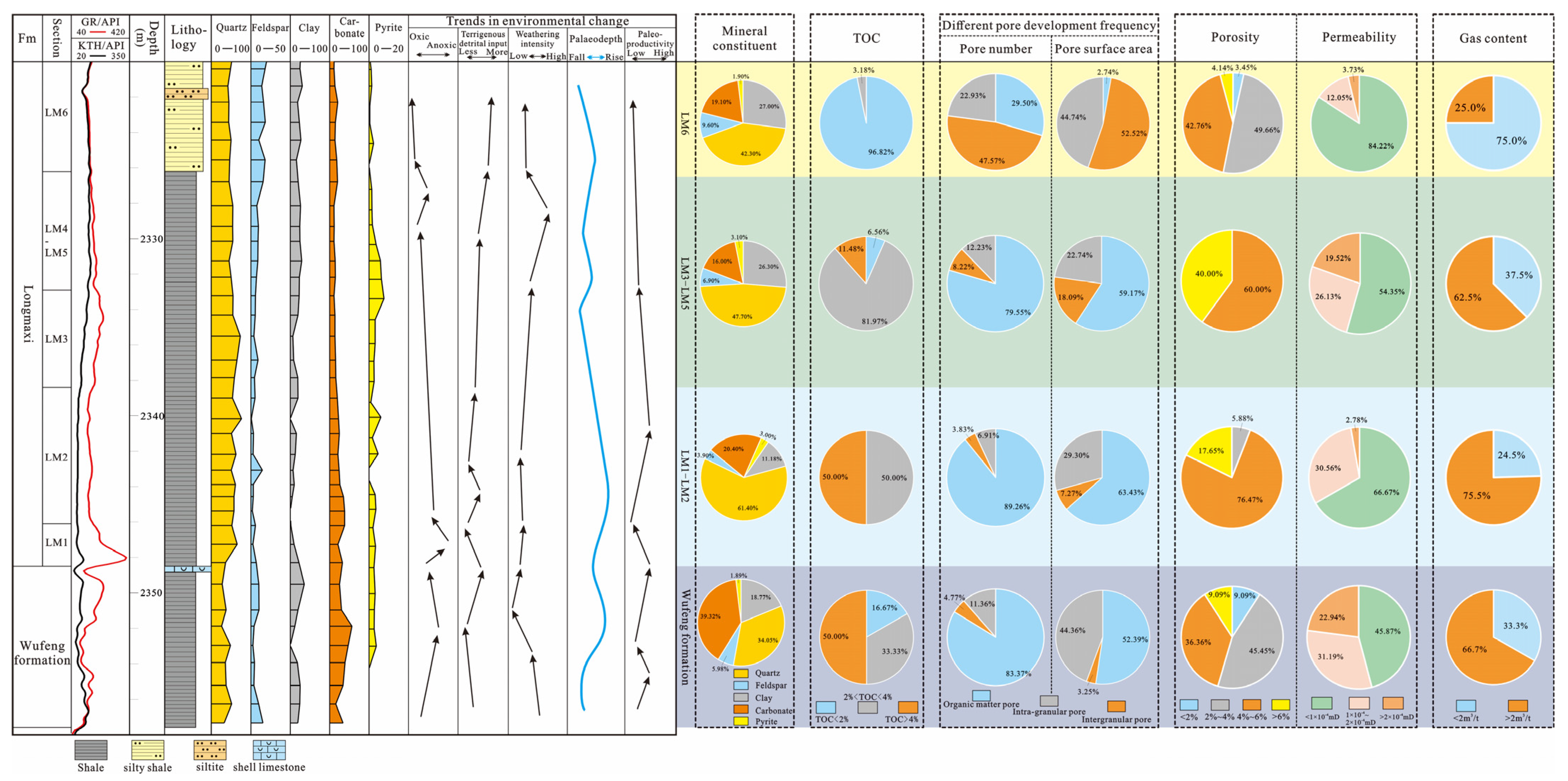
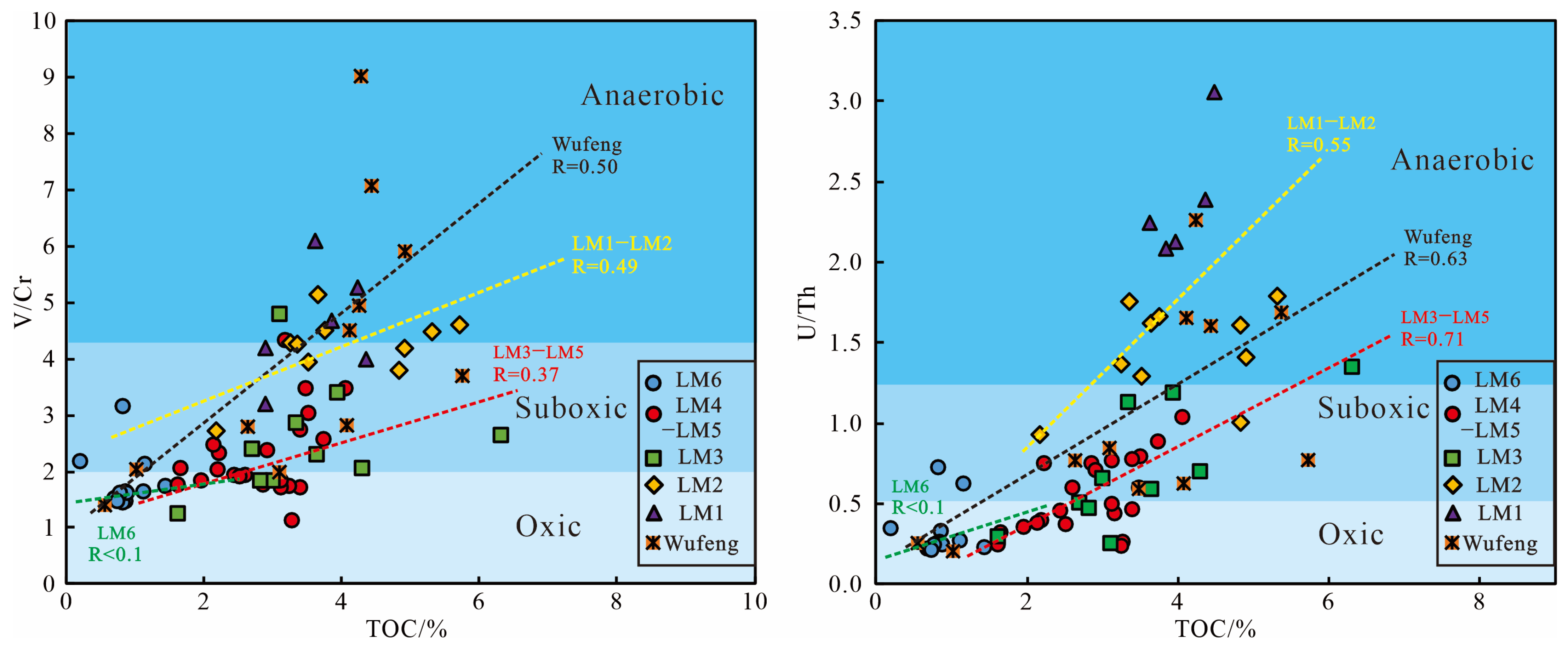


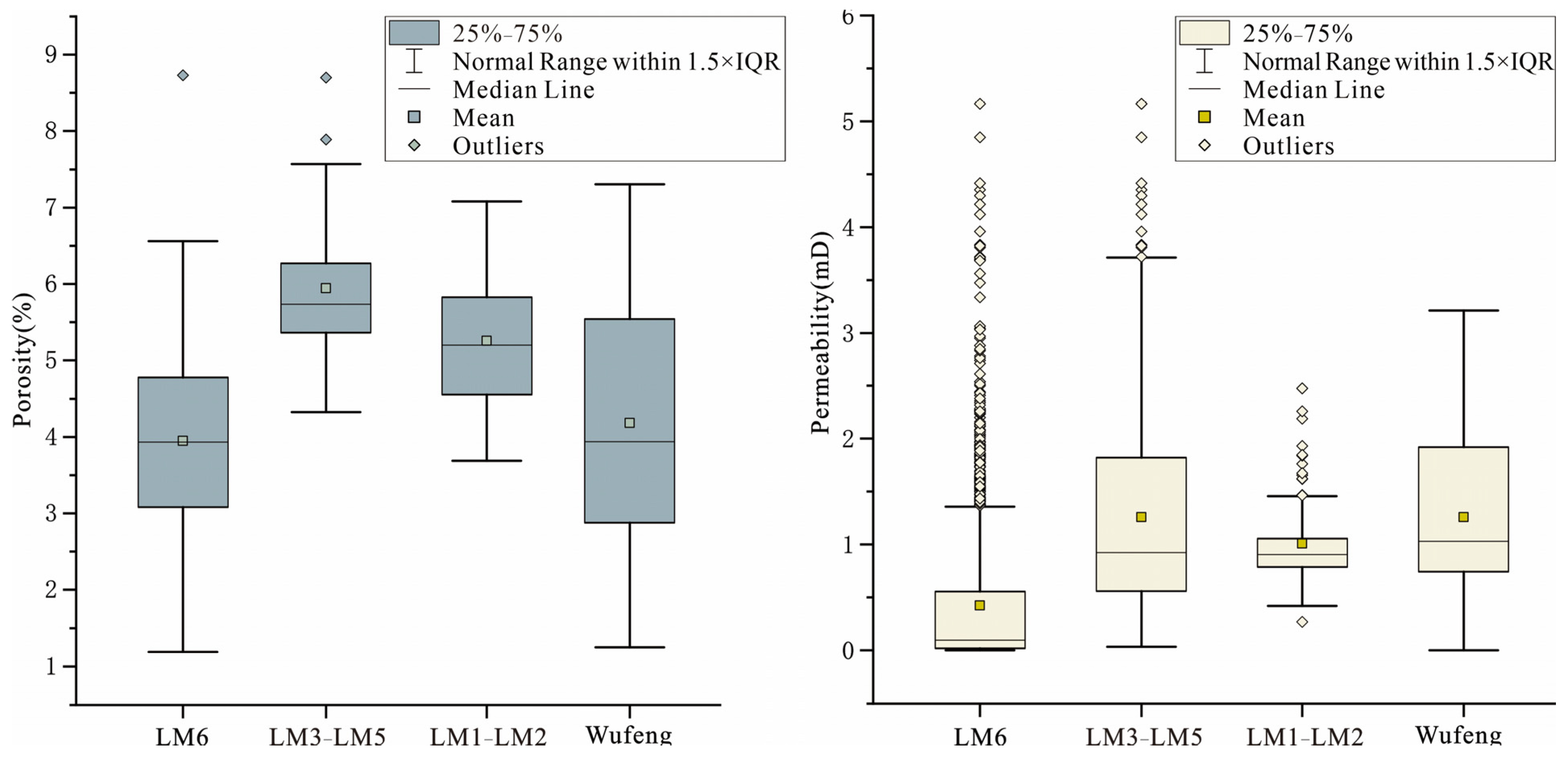
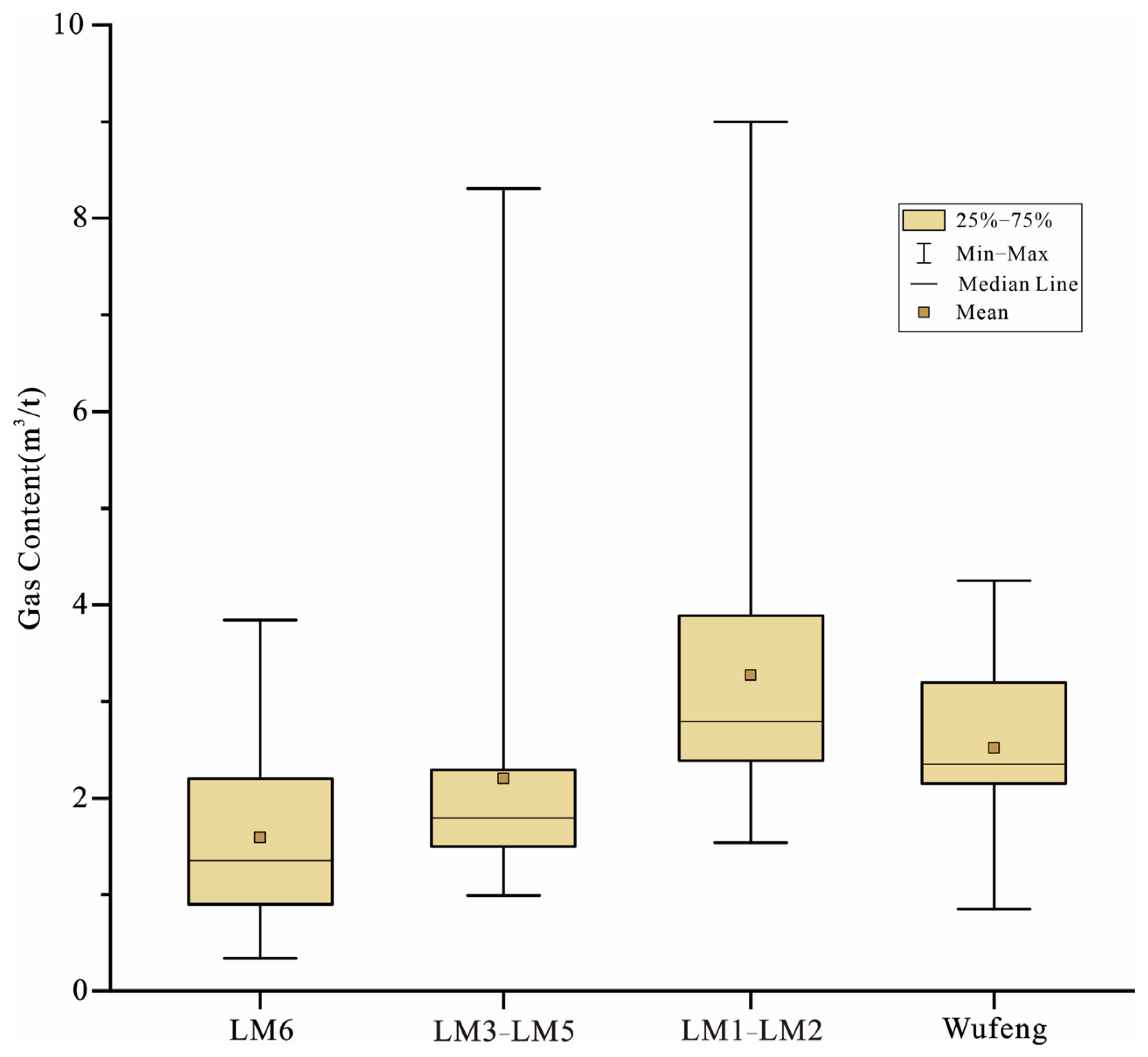
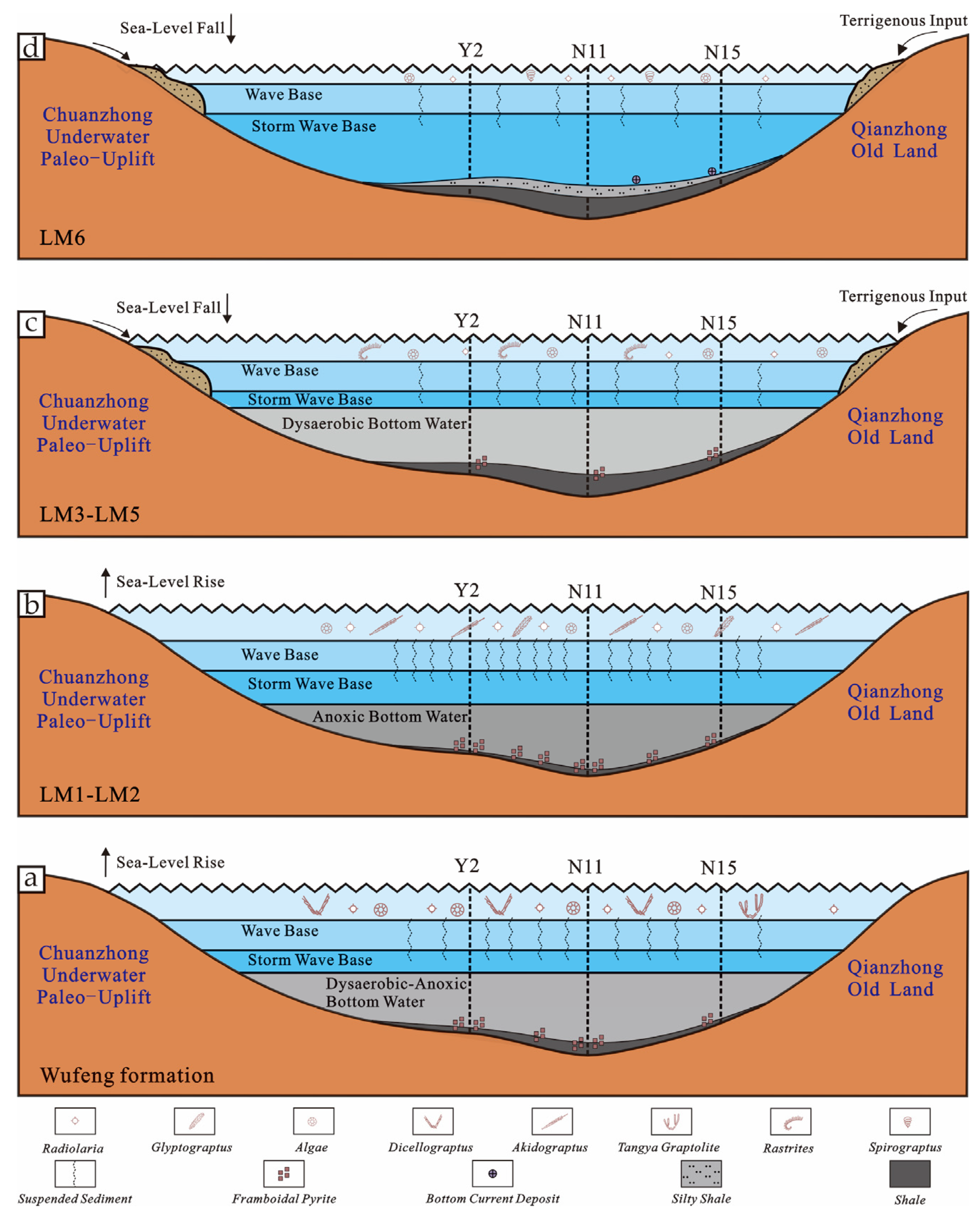
| Proxy | F-Value | p-Value | Eta-Squared (η²) | |
|---|---|---|---|---|
| Redox Enviroment | V/Cr | 9.62 | <0.001 | 0.38 |
| V/(V+Ni) | 5.18 | <0.001 | 0.24 | |
| U/Th | 6.99 | <0.001 | 0.31 | |
| Terrigenous Detrital | Al (%) | 3.57 | 0.006 | 0.21 |
| Ti (%) | 3.21 | 0.012 | 0.18 | |
| Zr (ppm) | 3.19 | 0.011 | 0.18 | |
| Paleoclimate | CIA | 5.62 | <0.001 | 0.26 |
| Paleo-Water-Depth | Na2O/K2O | 8.48 | <0.001 | 0.35 |
| Paleoproductivity | Babio | 6.48 | <0.001 | 0.30 |
| Sibio | 7.94 | <0.001 | 0.41 | |
| P/Al | 3.87 | 0.004 | 0.20 | |
| Mobio | 6.19 | <0.001 | 0.28 | |
| Section | V/Cr | V/(V + Ni) | U/Th | |||
|---|---|---|---|---|---|---|
| Range | Mean | Range | Mean | Range | Mean | |
| LM6 | 1.45~3.17 | 1.79 | 0.68~0.77 | 0.73 | 0.22~0.73 | 0.32 |
| LM4–LM5 | 1.14~4.14 | 2.30 | 0.62~0.83 | 0.71 | 0.24~1.04 | 0.55 |
| LM3 | 1.25~4.79 | 2.54 | 0.64~0.87 | 0.69 | 0.25~1.35 | 0.72 |
| LM2 | 2.72~5.15 | 4.13 | 0.66~0.7 | 0.68 | 0.93~1.79 | 1.41 |
| LM1 | 2.94~13.73 | 6.55 | 0.59~0.81 | 0.70 | 0.63~9.46 | 3.49 |
| Wufeng | 1.41~9.00 | 4.01 | 0.54~0.79 | 0.66 | 0.2~2.26 | 0.97 |
| Section | Al(%) | Ti(%) | Zr(ppm) | |||
|---|---|---|---|---|---|---|
| Range | Mean | Range | Mean | Range | Mean | |
| LM6 | 5.28~9.85 | 7.54 | 0.24~0.43 | 0.36 | 92.60~328.00 | 187.82 |
| LM4-LM5 | 5.10~9.88 | 7.09 | 0.24~0.40 | 0.32 | 68.40~305.00 | 170.03 |
| LM3 | 5.16~13.54 | 7.34 | 0.26~0.38 | 0.32 | 101.00~292.00 | 153.58 |
| LM2 | 3.03~5.95 | 4.25 | 0.15~0.29 | 0.21 | 56.30~128.00 | 85.97 |
| LM1 | 2.48~4.91 | 3.70 | 0.11~0.27 | 0.19 | 52.60~122.00 | 77.88 |
| Wufeng | 1.24~9.93 | 5.36 | 0.07~0.72 | 0.27 | 50.50~373.00 | 141.17 |
| Section | Chemical Index of Alteration (CIA) | Paleoclimate Environment | ||
|---|---|---|---|---|
| Minimum Value | Mean Value | Maximum Value | ||
| LM6 | 69.37 | 71.78 | 74.45 | Warm-humid environment |
| LM4-LM5 | 70.78 | 72.70 | 73.65 | |
| LM3 | 68.89 | 71.91 | 76.04 | |
| LM2 | 70.24 | 71.08 | 72.88 | |
| LM1 | 68.31 | 69.75 | 70.84 | |
| Wufeng | 64.6 | 70.72 | 75.32 | |
| Section | Well N11 | Well N15 | Well Y2 | Changning Area | ||||
|---|---|---|---|---|---|---|---|---|
| Range | Mean | Range | Mean | Range | Mean | Range | Mean | |
| LM6 | 0.16~0.20 | 0.18 | 0.23~0.24 | 0.23 | 0.15~0.15 | 0.15 | 0.15~0.24 | 0.18 |
| LM4–LM5 | 0.16~0.29 | 0.22 | 0.15~0.21 | 0.18 | 0.17~0.34 | 0.21 | 0.15~0.34 | 0.20 |
| LM3 | 0.22~0.24 | 0.23 | 0.19~0.22 | 0.21 | 0.16~0.38 | 0.27 | 0.16~0.38 | 0.22 |
| LM2 | 0.23~0.38 | 0.30 | 0.23~0.27 | 0.25 | 0.20~0.23 | 0.22 | 0.20~0.38 | 0.26 |
| LM1 | 0.29~0.35 | 0.32 | 0.26~0.26 | 0.26 | 0.30~0.30 | 0.30 | 0.26~0.35 | 0.29 |
| Wufeng | 0.15~0.39 | 0.25 | 0.15~0.21 | 0.18 | 0.09~0.62 | 0.37 | 0.09~0.43 | 0.24 |
| Section | Babio (ppm) | Sibio (%) | P/Al (×1000) | Mobio (ppm) | ||||
|---|---|---|---|---|---|---|---|---|
| Range | Mean | Range | Mean | Range | Mean | Range | Mean | |
| LM6 | 90.0~2197.0 | 1048 | 0.0~12.7 | 0.7 | 4.1~11.1 | 5.9 | 2.6~30.1 | 7.2 |
| LM4–LM5 | 61.0~7065.0 | 1295 | 0.0~13.3 | 1.5 | 4.6~12.4 | 6.3 | 8.6~41.4 | 20.9 |
| LM3 | 299.0~6894.0 | 1357 | 0.0~8.2 | 2.7 | 3.0~12.2 | 7.7 | 4.3~57.3 | 25.5 |
| LM2 | 286.0~2890.0 | 1328 | 9.9~23.0 | 15.4 | 7.1~13.2 | 9.2 | 26.2~70.3 | 52.7 |
| LM1 | 310.0~1971.0 | 1189 | 6.0~27.6 | 14.9 | 8.1~20.1 | 14.0 | 11.1~161.4 | 82.9 |
| Wufeng | 252.0~4308.0 | 1263 | 2.5~23.5 | 7.4 | 3.8~26.2 | 14.6 | 11.9~77.7 | 35.8 |
| Section | Sedimentary Environment | Mineralogical Composition Characteristics | |||||||
|---|---|---|---|---|---|---|---|---|---|
| Redox Conditions | Terrigenous Clastic Input | Basinal Restricted Environment | Paleo-Marine Productivity | Quartz (%) | Feldspa (%) | Clay Minerals (%) | Carbonate Minerals (%) | Pyrite (%) | |
| LM6 | Dysoxic-Oxic | Abundant | Semi-restricted | Severely suppressed | 42.33 | 9.65 | 27.05 | 19.12 | 1.87 |
| LM3-LM5 | Dysoxic | Moderate | Moderately depressed | 47.66 | 6.89 | 26.34 | 16.00 | 3.10 | |
| LM1-LM2 | Anoxic | Negligible | Exceptionally high | 61.45 | 3.92 | 11.18 | 20.42 | 3.03 | |
| Wufeng | Dysoxic-Anoxic | Low | Highly restricted | Enhanced | 34.05 | 5.98 | 18.77 | 39.32 | 1.89 |
| Proxy | Regression Coefficient (β) | F-Value | p-Value | Coefficient of Etermination (R²) |
|---|---|---|---|---|
| Redox (U/Th) | 0.744 | 16.92 | <0.001 | 0.186 |
| Productivity (Mobio) | 0.033 | 42.61 | <0.001 | 0.368 |
| Terrigenous (Al) | −0.058 | 9.48 | 0.002 | 0.114 |
Disclaimer/Publisher’s Note: The statements, opinions and data contained in all publications are solely those of the individual author(s) and contributor(s) and not of MDPI and/or the editor(s). MDPI and/or the editor(s) disclaim responsibility for any injury to people or property resulting from any ideas, methods, instructions or products referred to in the content. |
© 2025 by the authors. Licensee MDPI, Basel, Switzerland. This article is an open access article distributed under the terms and conditions of the Creative Commons Attribution (CC BY) license (https://creativecommons.org/licenses/by/4.0/).
Share and Cite
Liao, C.; Chen, L.; Lu, C.; Chen, K.; Zheng, J.; Chen, X.; Wang, G.; Cao, J. Depositional and Paleoenvironmental Controls on Shale Reservoir Heterogeneity in the Wufeng–Longmaxi Formations: A Case Study from the Changning Area, Sichuan Basin, China. Minerals 2025, 15, 677. https://doi.org/10.3390/min15070677
Liao C, Chen L, Lu C, Chen K, Zheng J, Chen X, Wang G, Cao J. Depositional and Paleoenvironmental Controls on Shale Reservoir Heterogeneity in the Wufeng–Longmaxi Formations: A Case Study from the Changning Area, Sichuan Basin, China. Minerals. 2025; 15(7):677. https://doi.org/10.3390/min15070677
Chicago/Turabian StyleLiao, Chongjie, Lei Chen, Chang Lu, Kelin Chen, Jian Zheng, Xin Chen, Gaoxiang Wang, and Jian Cao. 2025. "Depositional and Paleoenvironmental Controls on Shale Reservoir Heterogeneity in the Wufeng–Longmaxi Formations: A Case Study from the Changning Area, Sichuan Basin, China" Minerals 15, no. 7: 677. https://doi.org/10.3390/min15070677
APA StyleLiao, C., Chen, L., Lu, C., Chen, K., Zheng, J., Chen, X., Wang, G., & Cao, J. (2025). Depositional and Paleoenvironmental Controls on Shale Reservoir Heterogeneity in the Wufeng–Longmaxi Formations: A Case Study from the Changning Area, Sichuan Basin, China. Minerals, 15(7), 677. https://doi.org/10.3390/min15070677






